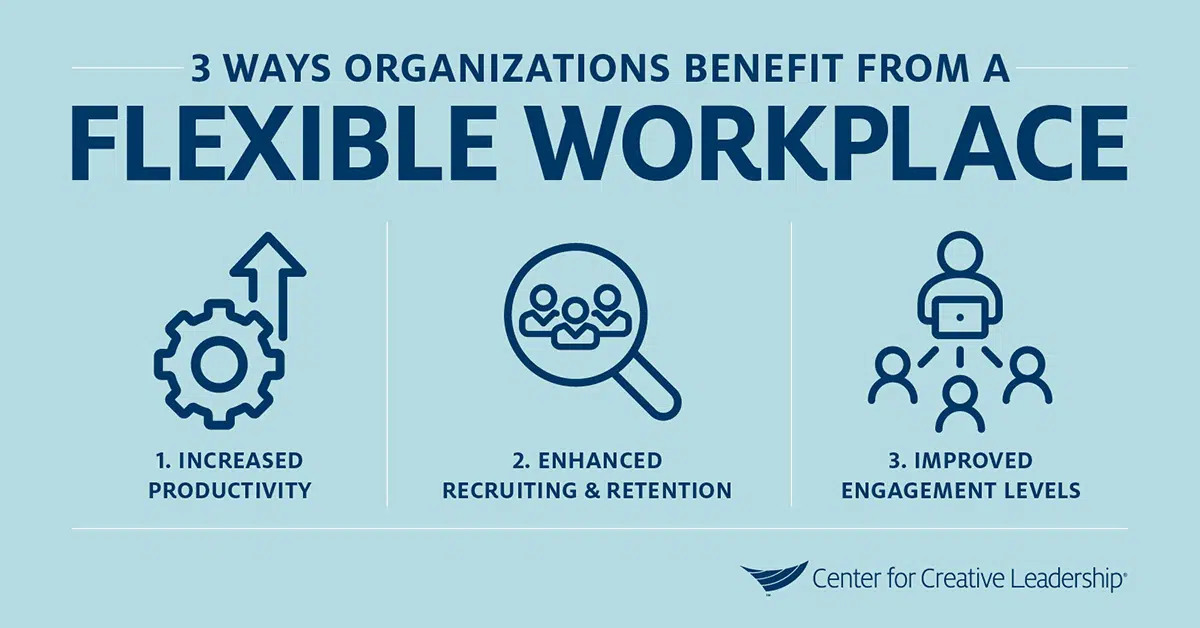And How Flexible Work Benefits Organizations
In the not-so-distant past, requests for flexibility in the workplace were typically taken on a case-by-case basis. Maybe an employee needed to leave early each Tuesday to pick up a child from school, and to make up the time, they’d extend their work hours on Wednesdays. Or maybe one team would would remotely for a certain period of the month.
Supervisors were flexible as needed; but flexibility was the exception, not the rule.
But that was pre-pandemic, when 3 out of 4 organizations had fewer than 10% of their employees working remotely. Those statistics — along with employees’ definition of flexibility — changed in 2020 when the global pandemic forced organizations to adapt to a new virtual world and unlearn previously held beliefs about culture and worker productivity.
Today “business as usual” looks a little unusual. For the first time in a long time, employees hold the bargaining power.
During the pandemic, employees worked long hours to help their organizations survive. When offices were closed and companies were losing revenue, employees answered the call. Productivity was high, but so was stress.
After working at an unsustainable pace, many people are stepping back and asking themselves what they really want to do with their lives and with their careers. They’ve realized working more hours does not equal more productivity, and instead can lead to burnout.
Millions of people have recently left their jobs in “The Great Resignation,” as employees are questioning the meaning of their work and rethinking what they want from their lives.
What workers want is more flexibility in the workplace — and not a return to the pre-COVID definition of flexibility. They want an overhaul in their organizations’ expectations for when and where they’ll work.
Why Do Organizations Need to Be Flexible?
Why? While employees were working from home, they made some important realizations. First, they liked not having a commute. Second, they saved a lot of money — some reported an average savings of $5,000 or more a year. Finally, they felt more productive.
According to Envoy’s recent Return to the Workplace Report, nearly half of the employees surveyed said they’d leave their jobs after the pandemic if their employers didn’t offer flexibility in the workplace going forward: a hybrid model that combines work-from-home and in-office work.
In fact, the majority of employees say they want flexible and remote work options to remain — one study even found that 64% would prefer a permanent work-from-home situation over a $30K pay raise.
If organizations want to succeed in the future, it’s not a question of if they should be flexible, but how they will be flexible.
How to Offer Flexibility in the Workplace
Your organization’s version of flexibility will depend on the type of work you do and the feedback you get from your employees. Some organizations are implementing a hybrid workforce model, whereas others are inviting employees to set their own schedule within a defined framework.
Going forward, the burden of success will fall to individual managers and leaders. Flexibility in the workplace will mean that individuals have the opportunity to work with their managers to determine a schedule that makes the most sense for their position and their responsibilities.
Because employees are the driving force behind this new, flexible work model, HR executives should involve their employees from the early stages of the process. Some organizations are conducting surveys to find out how the majority of their people feel about working from home or in the office. Others are holding roundtable discussions, and still others are scheduling meetings between supervisors and their teams. The goal is to determine how organizations can create a workplace that leads to enhanced productivity and engagement.
As the transition to a hybrid workplace model or other flexible work arrangements ensue, equity may be a concern. There will be questions surrounding fairness, as people struggle to understand why some of their colleagues get to work from home, while others don’t. There will be concerns about a bias favoring those who work more often in person rather than virtually.
Your organization’s policies should address these concerns and include these role-specific expectations. Be transparent about the criteria you’re using to determine which jobs require people to be in the office, versus those that can more easily be accomplished remotely.
And regardless of where and when people are working, career advancement opportunities, resources, and investments in leadership development should be applied equitably. You can foster a culture of trust by keeping in close touch with your employees and addressing any questions they might have.
How Do Organizations Benefit From Increasing Workplace Flexibility?
3 Key Ways Increased Flexibility in the Workplace Benefits Organizations
Offering greater flexibility in workplace arrangements doesn’t just benefit individual employees. The businesses and organizations they work for benefit, too — primarily in the areas of increased productivity and attracting, retaining, and engaging top talent.
1. Increased productivity.
Traditionally, most organizations believed their employees needed to be on-site to maximize their productivity. But according to an April 2021 survey by The Conference Board, 60% of HR leaders reported that productivity actually increased in their organizations during the pandemic. Organizations now know they needn’t fear that productivity will slip when giving employees flexibility in the workplace; the pandemic has proven that work can happen virtually anywhere.
2. Enhanced recruiting and retention of talent.
In addition to enhanced productivity, offering flexibility in the workplace helps organizations retain their existing talent, boost morale, and attract new talent. If employees can work from anywhere, then senior HR leaders and recruiters can cast a wide net to find the best talent available.
Flexibility also becomes a part of your culture, which helps with recruiting and retaining top talent. In the past, organizations leaned heavily on their physical space and amenities to define their culture. Many touted nice offices, great coffee and snacks, comfortable collaborative workspaces, and interesting furniture. But all that matters less when teams are not co-located.
3. Improved employee engagement levels.
Within a new virtual construct, HR leaders are rethinking how to build and maintain a remote work culture to keep employees engaged and productive. In a new hybrid environment where teamwork, communication, and engagement are more important than in-office perks like walking trails and expansive cafeterias, offering flexibility in the workplace is an important cultural differentiator that can help you increase employee motivation and engagement.
Access Our Webinar!
Watch our webinar, How to Improve Employee Retention Post-Pandemic with Flexible Work Arrangements, and learn tactics organizations can use to keep top talent engaged and productive in the new world of work.
Maintain Flexibility in the Workplace Going Forward
Build Conversational Skills & Hold Regular Check-Ins to Help Strengthen Your Culture
To ensure that flexibility in the workplace continues to enhance productivity, managers will need to understand best practices for virtual collaboration and hone in on 2 important skills: communication and coaching.
These skills will be especially important as leaders schedule regular check-ins with their employees who may or may not be working in the same location. During these check-in meetings, they should:
- Use active listening skills to understand what’s working and what’s not;
- Communicate the organization’s needs;
- Give effective feedback on the employee’s performance; and
- Provide coaching if there’s a developmental need.
Most importantly, leaders should understand that establishing flexibility in the workplace is an ongoing process — not an overnight fix. The COVID pandemic has unquestionably been the biggest disruption to work we’ve seen in a generation.
As this new way of working unfolds over the coming years, organizations should be agile and open to trial and error.
As the world of work continues to encounter rapid changes, organizations must intentionally build new capabilities to adapt to employee needs and ensure a positive and successful culture. Not only is it important to cultivate flexible leaders at an individual level, but organizations as a whole must embrace flexibility in the workplace to ensure they remain agile and ready to take on what comes next.
Ready to Take the Next Step?
Retain talent and build a productive work culture — wherever your employees are located — by embracing flexibility in the workplace. Partner with us to help strengthen conversational skills so your people are prepared to lead in today’s new hybrid workplace context.









